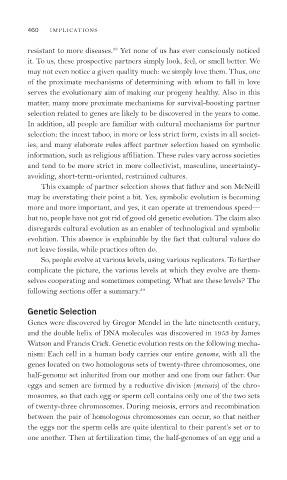Page 495 - Cultures and Organizations
P. 495
460 IMPLICATIONS
38
resistant to more diseases. Yet none of us has ever consciously noticed
it. To us, these prospective partners simply look, feel, or smell better. We
may not even notice a given quality much: we simply love them. Thus, one
of the proximate mechanisms of determining with whom to fall in love
serves the evolutionary aim of making our progeny healthy. Also in this
matter, many more proximate mechanisms for survival-boosting partner
selection related to genes are likely to be discovered in the years to come.
In addition, all people are familiar with cultural mechanisms for partner
selection: the incest taboo, in more or less strict form, exists in all societ-
ies, and many elaborate rules affect partner selection based on symbolic
information, such as religious affiliation. These rules vary across societies
and tend to be more strict in more collectivist, masculine, uncertainty-
avoiding, short-term-oriented, restrained cultures.
This example of partner selection shows that father and son McNeill
may be overstating their point a bit. Yes, symbolic evolution is becoming
more and more important, and yes, it can operate at tremendous speed—
but no, people have not got rid of good old genetic evolution. The claim also
disregards cultural evolution as an enabler of technological and symbolic
evolution. This absence is explainable by the fact that cultural values do
not leave fossils, while practices often do.
So, people evolve at various levels, using various replicators. To further
complicate the picture, the various levels at which they evolve are them-
selves cooperating and sometimes competing. What are these levels? The
following sections offer a summary. 39
Genetic Selection
Genes were discovered by Gregor Mendel in the late nineteenth century,
and the double helix of DNA molecules was discovered in 1953 by James
Watson and Francis Crick. Genetic evolution rests on the following mecha-
nism: Each cell in a human body carries our entire genome, with all the
genes located on two homologous sets of twenty-three chromosomes, one
half-genome set inherited from our mother and one from our father. Our
eggs and semen are formed by a reductive division (meiosis) of the chro-
mosomes, so that each egg or sperm cell contains only one of the two sets
of twenty-three chromosomes. During meiosis, errors and recombination
between the pair of homologous chromosomes can occur, so that neither
the eggs nor the sperm cells are quite identical to their parent’s set or to
one another. Then at fertilization time, the half-genomes of an egg and a

